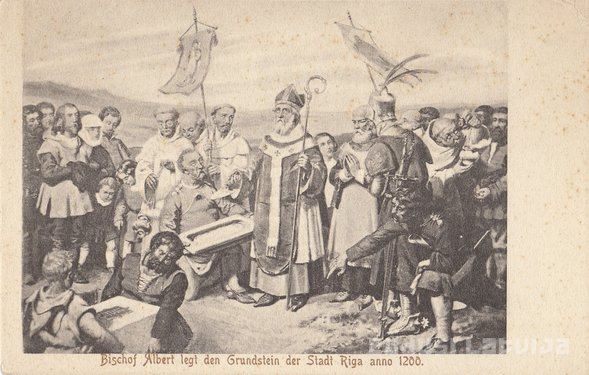
Today let's remember a battle that happened on this day, 15th of June in 1219, the battle of Lyndanisse in Estonia, where the Danish crusaders led by the mighty king Valdemar the Conqueror defeated the local Estonian pagans! This battle was also mythical birth of the Danish flag! 

This battle was part of the brutal centuries long conflict of Baltic crusades, a long series of wars that brought Christianity to this remote, hostile and ferocious part of Europe with fire and sword, as well as through brave missionaries and martyrs.
Danish king Valdemar II was a powerful king who had already expanded the borders of his kingdom greatly. He was called Valdemar the Victorious and Valdemar the Conqueror for a good reason! He extended Danish rule to Schleswig and Holstein, all of the Wendish lands and Pomerania! 



Valdemar was determined to conquer the eastern shores of Baltic and the territories of Estonia which were inhabitated by pagan tribes that were endangering Danish and Christian territories and Baltic trade with raids. Counties of Ancient Estonia in the beginning of the century: 

At the time, large parts of the neighboring region of Livonia were already conqured by the crusader order of warrior monks, the Sword Brethren, but they were surrounded with hostile pagans and needed support. Images of the brave crusader warriors of Christ, the Sword Brethren: 







The Livonian order of Sword Brethren and the local Livonian archbishop Albert of Riga were starting to ask the mighty Danish king for help against the pagans. The veteran warrior king Waldemar was eager to respond to the call of Christ and to expand his kingdom! Albert of Riga: 

In 1219, Waldermar embarked on a journey to Estonia with his elite Danish warriors, accompanied by his German and Wendish vassals from Principality of Rügen and Nordalbingia in Saxony. Their force was small, numbering around 1000-2000 men. Coats of arms of Rügen and Nordalbingia: 



The Baltic crusades were usually fought by small bands of crusaders, who had to rely on their bravery, skills and superior weapons. Building strong fortifications in the hostile wilderness and defending them was crucial as well. Illustration of Danish warriors from 1219 campaign: 

The pope Honorious III elevated Valdemar's campaign into a crusade. He gave the crusaders who would participate in Baltic campaigns indulgences, "remissio peccatorum" and "indulgentia peccatorum" All sins would be forgiven if they went on this journey and risk death for Christ!
When the Danish army landed in Estonia, near modern-day Tallinn in Revalia, the chiefs of the Estonians sat down with Danes pretending to want to negotiate to buy themselves more time. They also let themselves be baptized to give Danes a false sense of security and cooperation.
Three days later on 15 June 1219 while the Danes were attending mass, thousands of Estonians suddenly broke into the Danish camp from all sides. The Danes were taken by surprise and were in big trouble! Pagans even killed bishop Theoderich von Treyden, mistaking him for a king!
Luckily for Waldemar, his loyal vassal from Rügen Vitslav gathered his brave Wendish men in a second camp and attacked the Estonians from the rear. This counterattack which stopped the Estonian advance gave crusaders time to regroup. A fierce and brutal melee followed! 

During the hard fighting, the Archbishop of Lund Anders Sunesen raised his hands to the sky in prayer. A legend says that the defenders held tight as long as his hands were raised. As he became exhausted and to lowered his arms, the Estonians were on the verge of victory. 

What happened next is the mythical origin of the Danish flag, the famous "Dannebrog". As Bishop Sunesen started praying again as the Danes began to fall back, God gave the Danes a sign that he was on their side and a red banner with a white cross drifted down from the sky! 

As this banner that would become the Danish flag ever since was drifting down, a voice was heard to say "When this banner is raised on high, you shall be victorious!" After this divine inspiration the Danes surged forward and pushed the pagan enemies back, winning the battle!
Thousands of defeated Estonians lay dead on the field. The Danes constructed a great fortress at Reval called Castrum Danorum. In the next years, the pagan Estonians would rebel, but they could never conquer this fortress which they besieged in 1220 and 1223 but were repelled. 

The mighty Danish fortress of Reval (now known as the city of Tallin) became also a fortress of Christendom and an outpost of European civilization in this remote and brutal cold land. Maps of the situation in the Baltic in 1219 and 1223 (Teutonic knights would arrive in 1226): 



The Baltic crusades would rage on with much fervor and the fighting continued. The pagans of Estonia would soon rebel in a big uprising, but the Danish were able to eventually squash the rebelion. The red banner with white cross that appeared at Lyndanisse ruled over entire land! 

The heroic Danish king Valdemar the Conqueror, the king "the king of Dannebrog" left behind a great legacy as the last king of the Danish golden age. Even in Tallin, there is a Danish King's Garden commemorating a place where the Danish banner was born! 

People of Denmark should forever remember this great Danish hero Valdemar II, Valdemar the Conqueror or Valdemar Sejr as they began to call him in Danish. He gave them their glorious banner through a heroic battle! I hope this story is till told with a lot of pride in Denmark! 

• • •
Missing some Tweet in this thread? You can try to
force a refresh



















